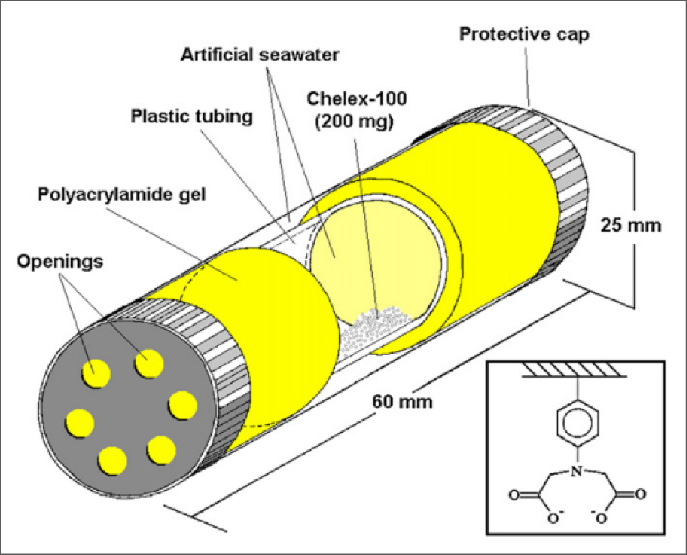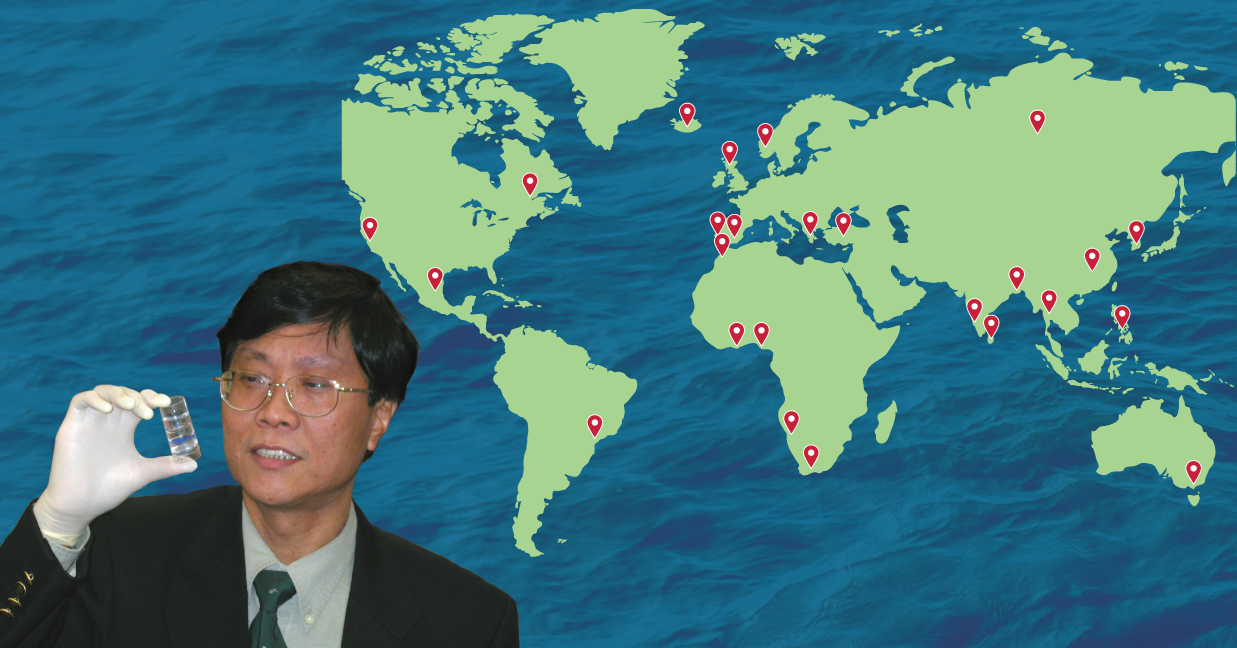参与成员:胡绍燊教授, 梁美仪教授, 招文瑛博士
为了克服监测海洋环境中金属长期存在的问题和局限性,胡绍燊教授的科研团队早于2007年研发了一套新的化学采样装置,称为人工贻贝(Artificial Mussel, AM)。该装置主要由浸于人工海水的高分配配位体 chelex 100 树脂、外壁为不透性有机玻璃、两端用半透过性聚丙烯醯胺 (polyacrylamide, SPP) 密封的管道构成。 SPP胶可以使金属离子通过孔隙缓慢渗透进入管道后与树脂螯合。
在苏格兰、冰岛、南非和葡萄牙水域的实地测试表明,AMs积累的常见有毒金属与活贻贝(living mussel) 相似 (Leung et al., 2008; Degger et al., 2011; Gonzalez-Rey et al., 2011; Claassens et al., 2016),但锌(Degger et al., 2011; Gonzalez-Rey et al., 2011) 和铅 (Leung et al., 2008; Gonzalez-Rey et al., 2011) 的积累模式则与活贻贝有显著差异。 Kibria等人(2012)应用AMs建立了澳洲维多利亚州内Goulburn-Murray淡水流域微量金属污染物的热点地图并评估了其对水生生态系统和公众卫生的潜在威胁。

Ruiz-Fernández等人(2018)发现,在墨西哥水域中汞和铀不能在牡蛎和贻贝积累,但可以被AMs检测到,表明AM可能比生物监测器更有效。基于中国沿海从温带到热带环境五个城市的综合研究,Degger等人(2016)得出的结论是: AMs可以提供可靠的时间综合估算,以评估不同水文条件和大范围水域内的金属浓度,并克服了监测水,沉积物和生物中金属的长期问题。同样地,沈等人(2020)对比澳洲沿海水域镉、铅、铜、锌、铬、硒、汞和砷八种微量金属在AMs和LMs中的积累模式,指出AMs能在多种微量金属的生物监控中作为活贻贝的良好替代品。
AMs首次实现了全球海洋环境中金属浓度的比较。
有关人工贻贝在全球范围内的应用研究已经发表在国际重要期刊Environment International, Environmental Pollution, Chemosphere, Ecological Indicators, Journal of Environmental Management, Marine Pollution Bulletin, Marine and Freshwater Research。
参考:
1. Claassens, L., Dahms, S., van Vuren, J.H.J. and Greenfield, R. (2016). Artificial mussels as indicators of metal pollution in freshwater systems: A field evaluation in the Koekemoer Spruit, South Africa. Ecological Indicators, 60, 940-946.
2. Degger, N., Chiu, J.M.Y., Po, B.H.K., Tse, A.C.K., Zheng, G.J., Zhao, D.M., Xu, D., Cheng, Y.S., Wang, X.H., Liu, W.H., Lau, T.C. and Wu, R.S.S. (2016). Heavy metal contamination along the China coastline: A comprehensive study using Artificial Mussels and native mussels. Journal of Environmental Management, 180, 238-246.
3. Degger, N., Wepener, V., Richardson, B.J. and Wu, R.S.S. (2011). Application of artificial mussels (AMs) under South African marine conditions: A validation study. Marine Pollution Bulletin63(5-12), 108-118.
4. Genc, T.O., Po, B.H.K., Yilmaz, F., Lau, T.C., Wu, R.S.S. and Chiu, J.M.Y. (2018). Differences in metal profiles revealed by native mussels and artificial mussels in Sarcay Stream, Turkey: implications for pollution monitoring. Marine and Freshwater Research, 69(9), 1372-1378.
5. Gonzalez-Rey, M., Lau, T.C., Gomes, T., Maria, V.L., Bebianno, M.J. and Wu, R.S.S. (2011). Comparison of metal accumulation between ‘Artificial Mussel’ and natural mussels (Mytilus galloprovincialis) in marine environments. Marine Pollution Bulletin, 63(5-12), 149-153.
6. Kibria, G., Lau, T.C. and Wu, R.S.S. (2012). Innovative ‘Artificial Mussels’ technology for assessing spatial and temporal distribution of metals in Goulburn-Murray catchments waterways, Victoria,Australia: Effects of climate variability (dry vs. wet years). Environment International, 50, 38-46.
7. Leung, K.M.Y., Furness, R.W., Svavarsson, J., Lau, T.C. and Wu, R.S.S. (2008). Field validation, in Scotland and Iceland, of the artificial mussel for monitoring trace metals in temperate seas.Marine Pollution Bulletin, 57(6-12), 790-800.
8. Ruiz-Fernandez, A.C., Wu, R.S.S., Lau, T.C., Perez-Bernal, L.H., Sanchez-Cabeza, J.A. and Chiu, J.M.Y. (2018). A comparative study on metal contamination in Estero de Urias lagoon, Gulf of California, using oysters, mussels and artificial mussels: Implications on pollution monitoring and public health risk. Environmental Pollution, 243, 197-205.
9. Shen, H., Kibria, G., Wu, R.S.S., Morrison, P. and Nugegoda, D. (2020). Spatial and temporal variations of trace metal body burdens of live mussels Mytilus galloprovincialis and field validation of the Artificial Mussels in Australian inshore marine environment. Chemosphere, 248, 126004.
10. Wu, R.S.S., Lau, T.C., Fung, W.K.M., Ko, P.H. and Leung, K.M.Y. (2007). An ‘artificial mussel’ for monitoring heavy metals in marine environments. Environmental Pollution, 145(1), 104-110.
